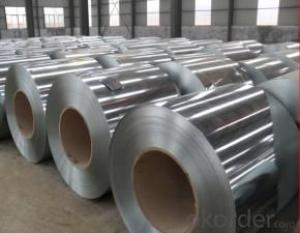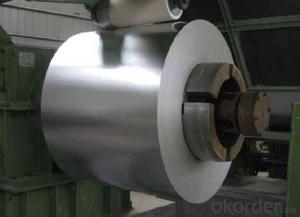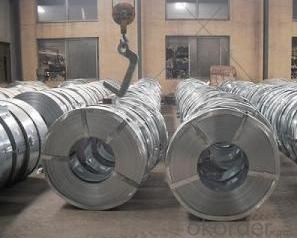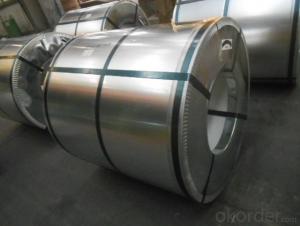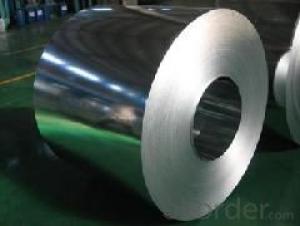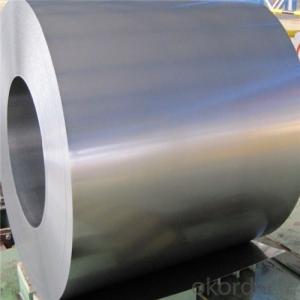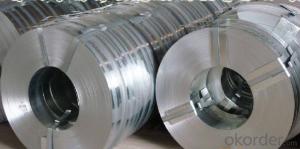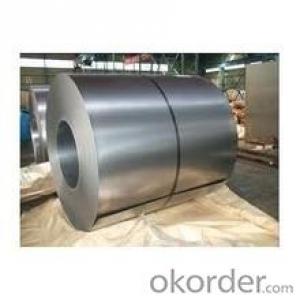Hot Dipped Zinc Galvanized Steel Coil for Construction
- Loading Port:
- Shanghai
- Payment Terms:
- TT OR LC
- Min Order Qty:
- 30 m.t.
- Supply Capability:
- 10000 m.t./month
OKorder Service Pledge
OKorder Financial Service
You Might Also Like
Product Details
Basic Info.
Model NO.:SGCC Hot Dipped Dx51d Dx52d Zinc Galvanized Steel
Surface Treatment:Galvanized
Certification:ISO, SGS, BV, RoHS, IBR
Technique:Cold Rolled
Standard:ASTM, JIS, GB, AISI, DIN, BS
Application:Roofing,Wall,Structure...
Edge:Mill
Stock:Stock
Steel Grade:Dx51d,SPCC,SGCC,CGCC,S350gd
Name:SGCC Hot Dipped Dx51d Dx52D Zinc Galvanized Steel
Thickness:0.14-1.2mm
Width:600-1250mm
Zn Coating:40-275GSM
Surface:Oiled,Galvanized,Chromated
Spangle:Zero,Small,Big,Regular
Coil Weight:3-10tons
Coil ID:508/610mm
Certificate:BV,ISO
Test:QA-QC-Mtc
Export Markets:Global
Additional Info.
Packing:1.Brown Paper 2.Plastic Cloth 3.Galvanized Plate
Standard:Thickness: 0.12mm-3mm
Origin:Shandong, China
HS Code:721049000
Production Capacity:30000 Tons/Year
Product Description
SGCC Zinc Coated Galvanized Steel Coil
ISO system
SGS and BV audited company.
Industry experience over 10 years.
Management systems-internal software
Finished product inventory-more than 500 tons.
Raw material inventory -over 800 mertic tons.
Shipment of goods -more than 30 countries worldwide.
We have the most convenient transport and prompt delivery.
We offer competitive price with best service.
We have high technical production line with top quality products.
We have win high reputation based on best quality products.
Specifications:
1. Zinc: 30g-275g/sqm
2. Coil weight:4-6 tons per coil
3. Edge treatment: Mill edge or cut edge.
4. Technical treatment: Bright annealed, flatting, cold harden.
5. Surface treatment: Annealed, bright finish, dull/bright finish, slit edge.
6. Spangle: Normal/small/big/zero spangle.
7. Delivery terms: FOB / C&R / CIF
8. Supply Ability: 30000MT/month
9. Application: The construction industry: The roof structure, keel, grill, Clapboard, ceilings, fire shutter doors, etc; The light industry, the Automobile, agriculture, animal husbandry, fishery, casing of household Electronic application, civilian smoke stack, etc.
10. Delivery time: Within 20 days after the receipt of L/C or Signed the contract or according to customer's requirement.
Special design available according to requirement; Anti-corrosion And high-temperature resistant with black painting; All the production process Are made under the ISO9001: 2000 strictly
Product Specification:
| Commodity | Galvanized Steel Coil For Construction | |||||||
| Technical Standard: | JIS 3302 / ASTM A653 / EN10143 | |||||||
| Grade | Base plate Style | Material | Standard | Application | ||||
| GI PLATE | TDC51D+Z | DC51D+Z | Commercial | |||||
| TDC52D+Z | DC52D+Z | Drawing/stamping | ||||||
| TDC53D+Z | DC53D+Z | Deep Drawing/stamping | ||||||
| TS280GD+Z/TS350GD+Z | S280GD+Z/S350GD+Z | Structure | ||||||
| TS550GD+Z | S550GD+Z | High strength structure | ||||||
| GL PLATE | TDC51D+AZ | DC51D+AZ | Commercial | |||||
| TDC52D+AZ | DC52D+AZ | Drawing/stamping | ||||||
| TS250GD/300GD/350GD+AZ | S250GD/300GD/350GD+AZ | Structure | ||||||
| TS550GD+AZ | S550GD+AZ | High strength structure | ||||||
| Coating Character | Pencil hardness | ≥H/2H | Category of Painting | Polyester | PE | |||
| Reverse impact | ≥9J/6J | High-durability polyester | HDP | |||||
| T bending | ≤ 3T/ 5T | Silicon modified polyesters | SMP | |||||
| Cuppingtest | ≥ 6mm/ 4mm | Polyvinylidene fluoride | PVDF | |||||
| MEK cleaning | ≥100/50 time | Easy-Cleaning | EC | |||||
| Primerabout 5 to 7 microns ; Top coated: about 8-20microns ; Back coated: about 5-15 microns (usual:5-7micron) | ||||||||
| Inspection | MTC will be handed on with shipping documents , accept the third party inspection | |||||||
| We accept the third party certificatation test | ||||||||
Hot Dip Cold Rolled Galvanized Steel coil
| Standard | AISI , ASTM , DIN , GB , JIS |
| Grade | DX51D / DX52D/ DX53D/ S250,280,320GD |
| Width | 600-1500mm |
| Thickness | 0.12-3mm |
| Zinc Coating | 40-275g |
| Coil ID | 508/610 mm |
| Coil Weight | 3-8 tons |
| Type of Coating | Hot dipped galvanized or Electronic Galvanized |
| Surface Structure | zero spangle / minimized spangle / regular spangle/ big spangle |
| Surface Treatment | chromed / skinpass/ oiled/slightly oiled/ dry/ anti-fingerprint |
| Package | export standard, plastic film+water proof paper + steel plate+ packing steel strip |
| Application | PPGI coil;construction,hardware, home appliances,interior decoration etc. |
| Price Items | FOB , CFR , CIF |
| Payment Items | Negociate |
| Delivery Time | Delivery as your request |
| Remark | Insurance is all risks |
| We accept the third party certification test |
Technical Data >>>
Chemical Composition:
GRADE | C | Si | Mn | P | S | Ti |
SGCC/DX51D+Z | ≤0.10 | ≤0.50 | ≤0.60 | ≤0.10 | ≤0.030 | ≤0.020 |
DX52D+Z | ≤0.10 | ≤0.50 | ≤0.60 | ≤0.10 | ≤0.030 | ≤0.020 |
SGCD/DX53D+Z | ≤0.10 | ≤0.30 | ≤0.50 | ≤0.05 | ≤0.030 | ≤0.020 |
SGCE/DX54D+Z | ≤0.10 | ≤0.30 | ≤0.30 | ≤0.03 | ≤0.020 | ≤0.020 |
DX56D+Z | ≤0.10 | ≤0.30 | ≤0.30 | ≤0.03 | ≤0.020 | ≤0.020 |
Structural | ≤0.20 | ≤0.60 | ≤1.70 | ≤0.10 | ≤0.045 |
Hot Dip Cold Rolled Galvanized Steel Coil Mechanical Properties
GRADE | Yield Strength MPa | Tensile Strength MPa | Elongation % |
SGCC(DX51D+Z) | ≥205 | ≥270 | - |
SGCD(DX53D+Z) | - | ≥270 | 38 |
SGCE(DX54D+Z) | - | ≥270 | 40 |
DX56D+Z | - | ≥270 | 42 |
- Q: Want to construct a patio cover approx. 20 feet long. Only want to use a 6x6 or 8x8 post at each end. What size steel i-beam would I have to use to carry the load???
- Probably the reason some contractors don't like this idea is that your new built-up beam, being only 6 tall, is not going to allow the joists above to attach effectively. The triple microlam with steel plates is sooooooo overkill in strength, but doesn't have the height to allow the floor joists to proberly attach. Your span is not so great that a built-up beam wouldn't work great. Assuming that your second floor joists are 2 x 10, I would use 2- 2 x 10 with 1/2 plywood sandwiched between. This is all that you really need.
- Q: How are steel coils used in the manufacturing of shock absorbers?
- Steel coils are commonly used in the manufacturing of shock absorbers as they provide the necessary strength and flexibility to absorb and dampen shocks and vibrations. These coils are typically placed inside the shock absorber to support the weight of the vehicle and absorb the impact caused by uneven road surfaces. The coiled steel springs compress and expand to absorb the energy from the shocks, ensuring a smoother and more comfortable ride for the vehicle occupants.
- Q: What are the challenges in coil slitting for narrow strip widths?
- There are several challenges associated with coil slitting for narrow strip widths. One of the main challenges is maintaining accuracy and precision during the slitting process. When dealing with narrow strip widths, even the slightest misalignment or deviation can result in significant defects or inconsistencies in the final product. This requires careful calibration and adjustment of the slitting equipment to ensure that the strips are cut with utmost accuracy. Another challenge is the risk of material damage or deformation during the slitting process. Narrow strip widths are more prone to distortion, wrinkling, or edge cracking, especially if the material is not properly handled or supported during slitting. Special care must be taken to ensure that the material is fed smoothly through the slitting machine and that the tension is properly controlled to minimize any potential damage. Additionally, narrow strip widths can pose challenges in terms of handling and transporting the slit coils. These coils are more susceptible to bending, twisting, or telescoping, which can lead to difficulties in stacking, storage, or transportation. Proper packaging and handling techniques must be employed to ensure that the slit coils maintain their shape and integrity throughout the supply chain. Furthermore, narrow strip widths often require more frequent blade changes during the slitting process. This increases the complexity and time required for setup and maintenance, as the blades need to be carefully selected and replaced to achieve optimal cutting results. It is crucial to have skilled technicians who can handle these blade changes efficiently and effectively. Overall, while coil slitting for narrow strip widths offers various benefits such as cost savings and increased material utilization, it also presents several challenges that need to be carefully addressed. These challenges include maintaining accuracy, preventing material damage, ensuring proper handling and transportation, and managing blade changes effectively. By understanding and addressing these challenges, manufacturers can optimize their coil slitting operations and produce high-quality narrow strip products.
- Q: i know that steel helmets werent meant to stop bullets, but i was wondering do they have an value whatsoever for stopping bullets, or is that just yet another thing that hollywood made up(like the omaha beach scene in saving private rian)
- They are meant to protect from shrapnel and flying objects,or an enemy's hit to the head. Not meant for protection against bullets [we didn't think so] but at the right angle you could get lucky. What they are useful for is boiling water for coffee etc. Shaving taking a who/e's bath and in the field very handy to have. The bad thing about pots is wearing,you must get accustomed to the weight on your head and neck. You don't think you ever will but finally you do,and because it's many uses and you must wear it,you do!
- Q: I know some .50 Cal BMG will do that, but what are some other cartridges ?Also, are all steel plate the same hardness ?
- At what range and angle of impact? And is this mild steel plate or armor plate and if it is armor plate is it cemented, face-hardened or RHA? What Brinell hardness is it?
- Q: How are steel coils measured?
- Steel coils are typically measured in terms of their width, thickness, and weight. The width is determined by measuring the distance across the coil's widest point, while the thickness is measured by gauging the thickness of the steel sheet. The weight of the coil is measured by weighing it using scales or load cells.
- Q: I know the law regarding selling steel core ammo, but is it possible to buy a steel core bullet and load it yourself?
- Please okorder / You're likely to find steel core ammunition from any of those manufacturers, and many more. Have fun... but steel core ammo is no more effective than lead ammunition, unless you're planning a crime spree and want to attempt to punch through a ballistic vest, and even that's not guaranteed.
- Q: What are the environmental and social impacts of mining, processing and using steel?
- I don't think society as we know it could exist without it. As for the enviroment there is damage from mining, processing and from using steel equiptment.
- Q: What are the common applications of cold-rolled stainless steel coils?
- Cold-rolled stainless steel coils have various common applications in industries such as automotive, construction, and manufacturing. They are commonly used in the production of appliances, kitchen equipment, roofing, and cladding materials due to their corrosion resistance, durability, and aesthetic appeal. Additionally, cold-rolled stainless steel coils are utilized in the fabrication of pipes, tubes, and structural components, as well as in the production of surgical instruments and medical equipment, owing to their sanitary and hygienic properties.
- Q: I have some steel wool and a charged 9V Battery, when I connect 2 wires to the battery, then touch the wool with the ends of the wires the wool instantly starts burning, but when I connect 2 wires to the piece of steel wool (a new piece not same one of course) and touch the battery with the ends of the wire nothing happens (see image...)
- Steel Wool 9v Battery
Send your message to us
Hot Dipped Zinc Galvanized Steel Coil for Construction
- Loading Port:
- Shanghai
- Payment Terms:
- TT OR LC
- Min Order Qty:
- 30 m.t.
- Supply Capability:
- 10000 m.t./month
OKorder Service Pledge
OKorder Financial Service
Similar products
Hot products
Hot Searches
Related keywords

